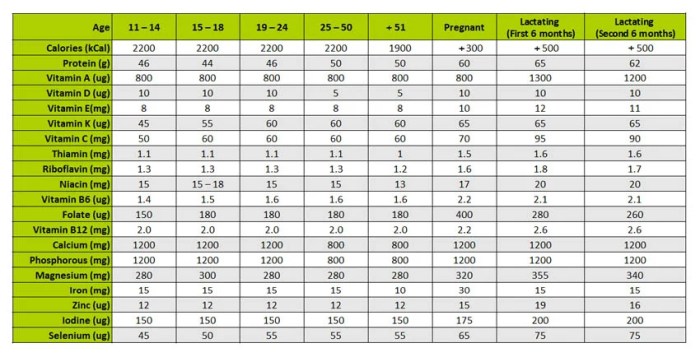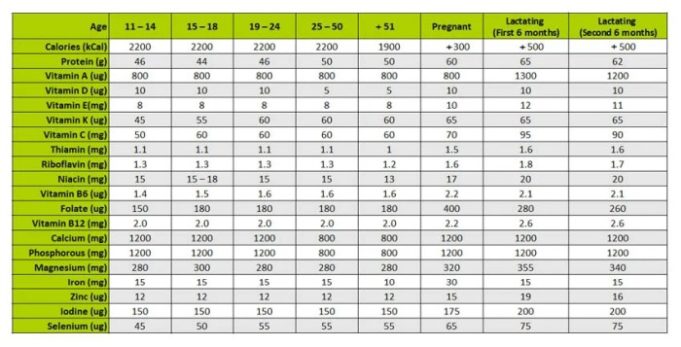Recommended dietary allowance table – The Recommended Dietary Allowance (RDA) table serves as a vital tool for understanding the essential nutrients our bodies need for optimal health. This comprehensive guide delves into the history, purpose, and practical applications of the RDA table, providing insights into how it shapes dietary recommendations and empowers individuals to make informed choices about their food intake.
The RDA table, developed by a collaborative effort of experts from various health organizations, provides a scientific framework for determining the adequate intake of essential nutrients for different age groups, genders, and life stages. It considers factors like growth, pregnancy, and breastfeeding to ensure optimal nutritional support throughout the lifespan.
Introduction to the Recommended Dietary Allowance (RDA) Table
The Recommended Dietary Allowance (RDA) table is a valuable tool for individuals and healthcare professionals to understand the nutritional needs of different populations. It provides guidelines for daily intake of essential nutrients, ensuring adequate consumption to maintain good health and prevent deficiencies. The RDA table has evolved significantly over time, reflecting advancements in scientific understanding of nutrition and the changing needs of society.
Historical Evolution of the RDA Table
The concept of recommended dietary allowances emerged in the early 20th century, driven by the recognition of nutritional deficiencies and their impact on public health. In the 1940s, the National Research Council (NRC) in the United States established the first set of RDAs, focusing on essential nutrients like vitamins, minerals, and protein. Over the decades, the RDA table has been revised and expanded to incorporate new scientific findings and changing dietary patterns.
The RDA table is a dynamic document, reflecting our growing knowledge of nutrition and its influence on health.
Organizations Responsible for Setting RDA Values
Several organizations play a crucial role in establishing and updating RDA values. The Food and Nutrition Board (FNB) of the National Academies of Sciences, Engineering, and Medicine (NASEM) in the United States is the primary authority for setting RDAs. The FNB conducts comprehensive reviews of scientific literature and expert consultations to develop evidence-based recommendations. Other organizations, such as the World Health Organization (WHO) and the Food and Agriculture Organization of the United Nations (FAO), also contribute to global dietary guidelines.
Interpretation of the RDA Table

The Recommended Dietary Allowance (RDA) table provides a valuable tool for understanding the nutritional needs of different population groups. By interpreting the RDA values, individuals can make informed choices about their diet to ensure they are meeting their daily requirements for essential nutrients.
RDA Values for Different Nutrients and Population Groups, Recommended dietary allowance table
The RDA table presents a comprehensive overview of recommended daily intakes for various nutrients, categorized by age, gender, and pregnancy or lactation status.
| Nutrient | RDA for Men (19-30 years) | RDA for Women (19-30 years) | RDA for Pregnant Women | RDA for Lactating Women |
|---|---|---|---|---|
| Vitamin A (µg RAE) | 900 | 700 | 770 | 1,200 |
| Vitamin C (mg) | 90 | 75 | 85 | 120 |
| Calcium (mg) | 1,000 | 1,000 | 1,000 | 1,300 |
| Iron (mg) | 8 | 18 | 27 | 9 |
| Zinc (mg) | 11 | 8 | 11 | 12 |
The table above illustrates the RDA values for selected nutrients across different population groups. It highlights the variations in nutritional requirements based on age, gender, and physiological status.
Understanding RDA Values and Their Implications for Health
The RDA values represent the average daily intake level of a nutrient that is sufficient to meet the needs of 97.5% of healthy individuals in a specific population group. They serve as a guideline for ensuring adequate nutrient intake and preventing deficiencies.
“Meeting the RDA for essential nutrients is crucial for maintaining overall health, supporting growth and development, and reducing the risk of chronic diseases.”
The RDA values are not absolute requirements and may vary depending on individual factors such as genetics, lifestyle, and health status. For instance, individuals with specific medical conditions or dietary restrictions may require higher or lower intakes of certain nutrients.
It is important to note that exceeding the RDA for some nutrients may also have negative health consequences. For example, excessive intake of vitamin A can lead to toxicity.
The RDA table provides a valuable resource for individuals, healthcare professionals, and policymakers to make informed decisions about dietary intake and promote optimal health.
Dietary Guidelines and the RDA Table
The RDA table, while providing essential information about nutrient requirements, is not the sole source of dietary guidance. It works in conjunction with other comprehensive dietary guidelines, such as the Dietary Guidelines for Americans, to provide a holistic approach to healthy eating.
Relationship Between Dietary Guidelines and the RDA Table
The RDA table provides a foundation for dietary recommendations by establishing minimum nutrient requirements to prevent deficiencies. However, it doesn’t encompass all aspects of healthy eating, such as:
- Food group recommendations: Dietary guidelines offer specific recommendations for the consumption of different food groups, like fruits, vegetables, grains, and protein sources, which contribute to overall dietary balance.
- Portion sizes: The RDA table focuses on nutrient amounts, but dietary guidelines provide guidance on appropriate portion sizes for various food groups to ensure adequate intake without overconsumption.
- Dietary patterns: Dietary guidelines emphasize the importance of adopting healthy dietary patterns, such as the Mediterranean diet or the DASH diet, which promote overall health and well-being.
- Lifestyle factors: While the RDA table primarily focuses on nutrients, dietary guidelines also address the role of lifestyle factors like physical activity, stress management, and adequate sleep in maintaining health.
The RDA Table’s Role in Informing Dietary Recommendations
The RDA table plays a crucial role in informing and supporting dietary recommendations by:
- Setting a baseline: The RDA table establishes a minimum level of nutrient intake required to prevent deficiencies, serving as a starting point for dietary recommendations.
- Guiding food choices: By providing nutrient content information for various foods, the RDA table helps individuals make informed food choices to meet their nutrient needs.
- Assessing dietary adequacy: The RDA table allows individuals and healthcare professionals to assess the adequacy of an individual’s diet by comparing their nutrient intake to the recommended values.
- Identifying potential deficiencies: The RDA table can help identify potential nutrient deficiencies by comparing an individual’s intake to the recommended values.
The RDA Table’s Contribution to the Overall Framework for Healthy Eating
The RDA table, in conjunction with other dietary guidelines, forms a comprehensive framework for healthy eating. This framework encompasses:
- Nutrient requirements: The RDA table establishes minimum nutrient requirements to prevent deficiencies, providing a foundation for dietary recommendations.
- Food group recommendations: Dietary guidelines provide specific recommendations for the consumption of different food groups to ensure a balanced diet.
- Dietary patterns: Dietary guidelines promote the adoption of healthy dietary patterns, which encompass various food groups and promote overall health.
- Lifestyle factors: Dietary guidelines emphasize the importance of incorporating healthy lifestyle factors, such as physical activity, stress management, and adequate sleep, for overall well-being.
Future Directions for the RDA Table
The Recommended Dietary Allowance (RDA) table is a dynamic document that evolves with our understanding of nutrition. Ongoing research and advancements in the field are constantly shaping our knowledge of nutrient requirements, leading to potential changes and updates to the RDA table in the future.
Emerging Research and Advancements
The field of nutrition is continuously evolving, with new research emerging that impacts our understanding of nutrient requirements. These advancements drive potential changes and updates to the RDA table, reflecting the latest scientific evidence.
- Personalized Nutrition: Research is increasingly focusing on individual variations in nutrient requirements based on factors like genetics, microbiome, and lifestyle. This personalized approach to nutrition may lead to the development of individualized RDA values in the future. For instance, genetic testing can reveal individual predispositions to certain nutrient deficiencies, leading to tailored dietary recommendations.
- The Gut Microbiome: The role of the gut microbiome in nutrient metabolism and overall health is becoming increasingly recognized. Research is exploring the influence of specific gut bacteria on nutrient absorption and utilization, potentially impacting future RDA recommendations. For example, studies have shown that certain gut bacteria can enhance the absorption of certain vitamins and minerals, while others may interfere with nutrient metabolism.
- Nutrient Interactions: Understanding how different nutrients interact with each other is crucial for determining optimal intake levels. Research is investigating the synergistic and antagonistic effects of nutrients, potentially leading to adjustments in RDA values. For example, studies have shown that vitamin D enhances calcium absorption, while excessive iron intake can interfere with zinc absorption.
Potential Updates and Changes
Based on emerging research, the RDA table may undergo future updates and changes to reflect the evolving understanding of nutrient requirements. These changes could involve:
- Revised RDA Values: As research provides new insights into nutrient requirements, the RDA values for specific nutrients may be adjusted to reflect the latest scientific evidence. For example, the RDA for vitamin D has been revised in recent years based on new research highlighting its importance for bone health and immune function.
- New Nutrient Categories: Emerging research may identify new nutrients with significant health implications, leading to the inclusion of new nutrient categories in the RDA table. For example, the inclusion of choline in the RDA table reflects its essential role in brain development and function.
- Expanded Age Ranges: The RDA table may be expanded to include more specific age ranges, reflecting the unique nutrient requirements of different life stages. For example, separate RDA values may be established for infants, toddlers, adolescents, and older adults.
Evolving Understanding of Nutrition
The RDA table is a dynamic document that reflects the evolving understanding of nutrition. As research continues to advance, our knowledge of nutrient requirements will continue to grow, leading to potential changes and updates to the RDA table.
Wrap-Up: Recommended Dietary Allowance Table
The RDA table, a testament to the advancement of nutritional science, plays a pivotal role in promoting public health by providing a standardized approach to dietary planning. By understanding the RDA values for various nutrients, individuals can make informed decisions to ensure they meet their nutritional needs and maintain optimal health and well-being.
Commonly Asked Questions
What are the differences between the RDA and the Daily Value (DV)?
The RDA focuses on meeting the needs of individuals, while the DV is used for food labeling and represents a general guideline for a standard 2,000-calorie diet.
How often are the RDA values updated?
The RDA values are reviewed and updated periodically by the Food and Nutrition Board of the National Academies of Sciences, Engineering, and Medicine, based on the latest scientific evidence.
Can I rely solely on the RDA table for my dietary planning?
While the RDA table is a valuable resource, it’s essential to consider individual factors like health conditions, lifestyle, and dietary preferences. Consulting with a registered dietitian or nutritionist can provide personalized guidance.
























